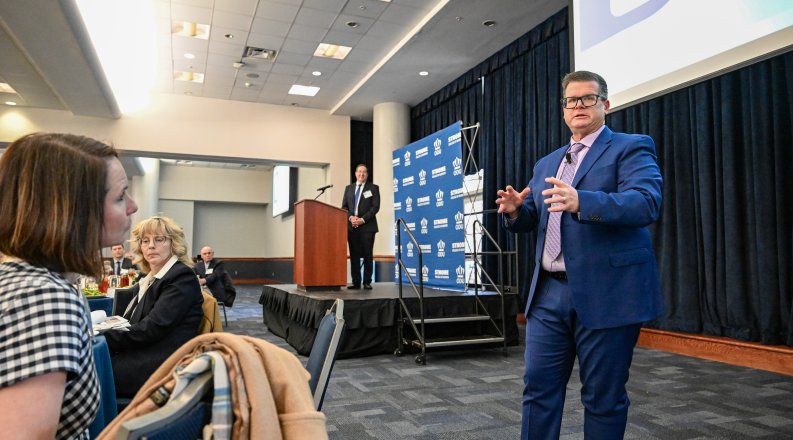Economists see signs of a third consecutive year of growth in the U.S. economy, but consumers still aren’t convinced.
That was one of the key findings in the 2024 Economic Forecast, delivered Wednesday by Dragas Center for Economic Analysis and Policy Director Robert M. McNab and Deputy Director Vinod Agarwal.
Consumer sentiment ranked worse in 2022 than during the recessions of 1980-81, 2011 and 2007-2009. In 2024, the economists anticipate sentiment will start to align closer to the data, contributing to continued economic growth.
“We have a disconnect between data and sentiment,” McNab said. “The question in 2023 was whether sentiment was going to change the data or whether the data was going to change the sentiment.”
He noted in their 2023 forecast, the Dragas Center economists anticipated potential for recession later in the year. Instead, they saw significant growth in the third and fourth quarters.
Barring unexpected shock, the ODU economists expect a third consecutive year of growth in the U.S. economy, with continued — albeit slower — job growth, increased consumer spending and lower interest rates by the end of 2024.
Inflation rates will continue to decrease in the first half of 2024, and it’s likely the Federal Reserve will reduce the discount rate by 50 basis points later this year.
Growth in the U.S. economy could be affected by increased global uncertainty. A broader conflict in the Middle East could lead to a resurgence of the supply chain difficulties that followed the pandemic in 2020-21.
Both nationally and at the state level, employment continues to increase and payrolls have surpassed pre-pandemic levels, but job openings are decreasing from a post-pandemic high in 2021.
“We’re not only recovering individual employment to pre-COVID levels, we’ve expanded upon it, as well,” McNab said.
Economic Conditions in Virginia
In Virginia, economic success depends heavily on federal spending. Discord in Congress continues to present risk for the state, where some estimate up to $3 of every $10 is touched by the federal government, McNab said. While Department of Defense spending is budgeted for a higher appropriation, the budget has only been approved through continuing resolutions.
“If you reside in Virginia, where one only needs to look around and see how much the federal government influences our economic activity, you will understand how political dysfunction in Congress impacts our income,” he said.
This is especially true in Hampton Roads, where roughly 40% of the local economy is tied to defense spending. “If Department of Defense spending doesn’t grow, we simply don’t grow,” Agarwal said. “We need assistance from the private sector to grow.”
Slower Recovery in Hampton Roads
Job recovery following the pandemic has been slower in Hampton Roads compared with the nation and the state.
The labor market appears to be closing the gap in job recovery, but Hampton Roads still lags the growth in payrolls seen in peer metropolitan areas, including Northern Virginia, Richmond and Charlotte, North Carolina.
“We simply are not creating enough jobs,” Agarwal said.
Agarwal identified several sectors showing opportunity for job growth, including life sciences, health sciences, cybersecurity and maritime. “Leaning into these industrial clusters is really a way to lessen our dependence on the federal government,” he said.
The economists took a close look at the Port of Virginia as an indicator of the health of Hampton Roads’ economy. In 2023, the port saw a decline in traffic moving in and out of Hampton Roads after record-setting growth in 2021. The volumes are declining, but the port has seen less loss than most other ports in the U.S. In 2024, the port is expected to see moderate growth in tonnage and loaded TEUs, the general unit of cargo measure for container ships and ports.
“The port has become efficient, and the investments in the port are paying off,” Agarwal said.
The regional hospitality industry strongly rebounded from pandemic lows, but the hotel industry still faces the threat of the growing market for whole-home vacation rentals. For the hotel industry to grow, Agarwal said, there needs to be a focus on growing demand for rooms.
For the past two years, inflation and rising interest rates, combined with a low housing supply, have been a source of stress for would-be home buyers and sellers. With lower annual mortgage rates anticipated in 2024, the economists expect existing home sales to stabilize. Median prices, however, may continue to increase.
“Unless the housing supply increases, don’t expect median prices to fall,” Agarwal said.
Ultimately, the economists encouraged attendees to focus on one big takeaway: don’t allow sentiment to cloud decision-making. “Look at what the data shows us,” Agarwal said. “2024 looks like a decent year.”
View the full Economic Forecast report.




